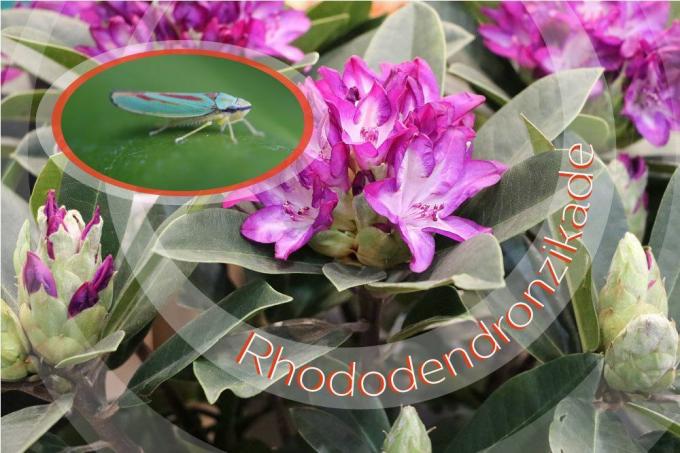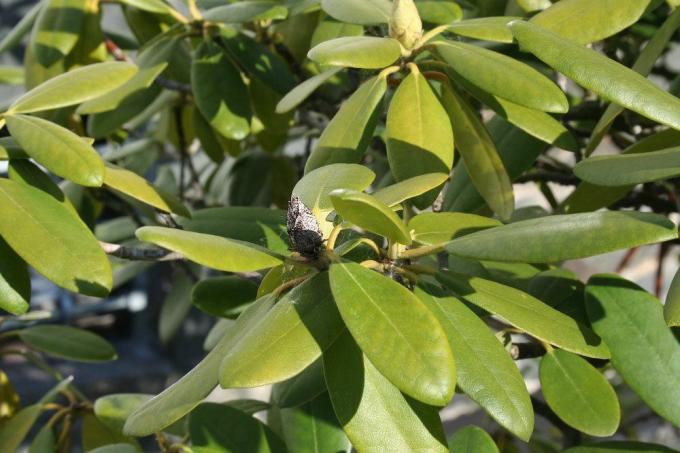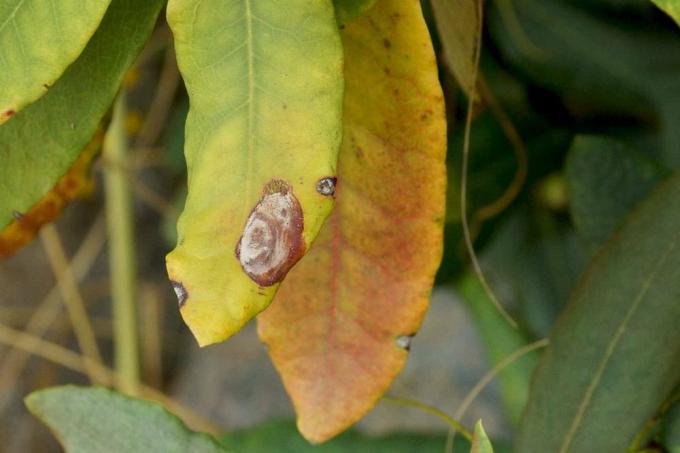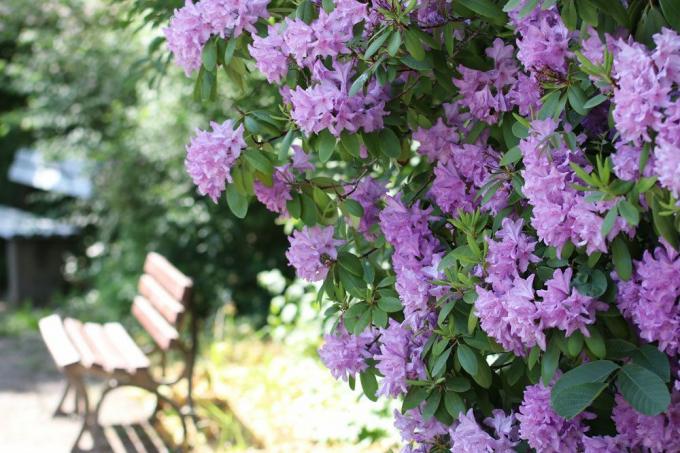
table of contents
- Damage image
- Rhododendron leaf hoppers
- Larvae
- infection
- Combat
- Pesticides
- Prevent
- Rhododendron variety
Suddenly the overwhelming bloom stays with you in the spring rhododendron in your own garden, it is worth investigating more closely. Often an inconspicuous culprit is at work who leaves a characteristic image of damage: the bud tan. At first glance, it is reminiscent of frost damage. In reality, it is a fungus that is transmitted by rhododendron leafhoppers. How you can fight the insects and prevent an infestation, you will find out in this article.
Damage image
Especially with larger plants, the flowers are often overwhelming in spring. If May progresses and the rhododendron only develops sparsely flowers, something is wrong. In many cases, the harsh winter is not to blame, when the flower buds are not lush green, but dark in color and dead. The real culprit for this clear damage, the so-called bud tan, is an inconspicuous fungus (Pycnostysanus azaleae). On closer inspection, fine black fungal threads can be seen over the entire bud. In this case, the flower buds have already completely died and can no longer be saved.
- Buds do not open
- brownish black color
- dead
- dark, hairy mushroom structures about 1 to 2 mm long on the surface
- towards the end spherical thickening of the threads
- from April light spots on the upper side of the leaf can also be seen (by sucking the larvae)
- green-yellow colored larvae on the underside of the leaf
- Molecular remnants of the larvae can be seen

Rhododendron leaf hoppers
The mushroom alone would not cause so much damage if it did not have a helper. The carrier of the rhododendron mushroom is Rhododendron leaf hoppers (Graphocephala coccinea or G. fennahi). The approximately one centimeter tall, light green insect with the striking red stripes on its back uses the plant to lay eggs. The green-red cicadas can be found in the garden from the end of July. If you touch the rhododendron, the cicadas jump up and hide on the underside of the leaf. Originally, rhododendron leaf hoppers are not native pests. They come from North America and were first introduced to Great Britain around 100 years ago and from there to Central Europe. We have had rhododendron leafhoppers for the first time since the 1970s.

Larvae
While the adult rhododendron cicadas are no longer dependent on the rhododendron as a source of food, the situation is different with the larvae. After the eggs are laid in late summer and autumn, the eggs hibernate cicada in the buds. The yellowish, flightless larvae hatch in April and can then be seen on the underside of the leaves on closer inspection. The larvae are already very agile after hatching and at this point rely on rhododendrons as their only source of food. During their development into adult rhododendron cicadas, the larvae molt several times up to the beginning of July. Although the larvae suck the sap from the underside of the rhododendron's leaf, they usually hardly cause any damage.
infection
An infestation with rhododendron leaf hoppers does not affect the shrub much. The female rhododendron cicada carves fine slits in the rhododendron buds to lay an egg in each. However, the eggs and larvae themselves do not cause the characteristic damage to the rhododendron buds. The fine wounds, which represent an entry opening for the harmful agent of the bud tan, are dangerous for the plants. It's a mushroom called Pycnostysanus azaleae. Only the fruiting bodies of the fungus are visible to the eye, which cover the bud as fine black hairs with a spherical thickening at the end and ensure the special damage pattern.
The fungus does not necessarily need these wounds to infect the rhododendron. However, if the protective skin of the plant is damaged, the fungus can penetrate the rhododendron much faster and easier. The infestation is unfortunately only noticeable in spring, as there are no visible symptoms beforehand.

Combat
In general, the question arises as to which of the two pests that are involved in the infection of the rhododendron should best be combated. Since a direct approach against the fungal pathogen is not possible, only the indirect method remains to combat the rhododendron cicada in good time with suitable means.
time
Since the fungus penetrates the plant when the eggs are laid in summer, it makes sense to do so in early summer take up the fight against the rhododendron leaf hoppers to prevent the plant from infecting in the first place will. It is helpful when fighting the insect that the cicada only lays eggs once a year. It is therefore important to interrupt this cycle by preventing eggs from being laid.
- Time to control the larvae: May to mid-July
- Time of oviposition: August to September
early detection
In order to spot the rhododendron cicadas before they lay their eggs, an occasional look at the rhododendron is necessary from July. Above all, the underside of the leaves and the buds should be carefully examined. Monitoring is very easy with glue-coated yellow boards. There are special yellow traps on the market with which the adult cicadas capable of flying can be caught. If the rhododendron is attacked by the insects, sooner or later cicadas will stick to the board. These should be hung in and above the endangered rhododendrons from June.
Pesticides
If the infestation is very severe, it is hard to avoid a pesticide. Before the first cicadas lay their eggs in the buds, action is required. For this purpose, there are system poisons in the trade that act against rhododendron leafhoppers.
- natural fight with Pyrethrin
- homemade broths with Neem oil or Neem meal

Inject properly
The above-mentioned pesticides are applied by spraying. It is essential to observe the safety instructions given by the manufacturer in order to keep the risk to humans, animals and the environment as low as possible. In addition, there are a few basic things to be observed so that the remedy can work effectively. In general, adult leafhoppers are relatively resistant to insecticides. For this reason, you should take action against the leafhoppers at the larval stage, if this is possible.
- preferably use the early morning hours to combat
- the insects are less agile due to the cold at night
- also completely spray the underside of the leaf
- Repeat the process every one to two weeks
- a total of at least three times
leaves
Since the leaves of the rhododendron have a water-repellent layer, professional gardeners recommend adding a few drops of detergent to the spray. The surfactants do not impair the effect of the agent, but merely ensure that the surface tension changes and the leaves are wetted more evenly.

Chemicals
Only when these pesticides show no effect in the event of a very severe infestation should chemical agents be used under certain circumstances. To minimize the risk of infection, all infected buds should be broken out in spring. Do not dispose of the buds in the garden, on the compost or in the organic waste bin, but put the waste in the household waste so that the fungus cannot spread any further.
Prevent
Once a rhododendron is infected, the fungus spreads over the years. So doing nothing against the rhododendron leafhoppers would be the wrong solution. Ultimately, not a single flower comes to maturity and the whole wood is full of dead buds. It is therefore important that you prevent a new infestation in the future. If you don't want to use poisons, you need a little more patience and the right timing. To prevent this, it is important to immediately break out and dispose of dead buds. This reduces the chance of further or stronger fungal infections.
- Regular control of the flower buds from spring
- if there are brown or black spots: break out immediately
- Hang up yellow boards from mid-June to September
- for smaller shrubs: tie light and air permeable fleece around the plant
Optimal soil conditions
Healthy, vigorous plants may not be completely resistant to pests, but they are less likely to be attacked. Should the harmful fungus occur, the extent of the damage is significantly less than with weakened rhododendrons. It is therefore important to ensure optimal site and soil conditions.
- acidic soil
- ideal pH value: around 5
- weathered forest floor
- Soil for bog plants or rhododendron soil
- Check the pH value regularly
- slightly damp
- avoid dry locations

Best practice
Getting a rhododendron that has been infected by the bud tan completely free of cicadas is usually a tedious process. However, whoever sensibly combines all control methods and preventive measures and these If applied consistently, the rhododendron leafhoppers can ideally be used in just one season exterminate. Because if the oviposition is prevented, there will be no new generation of cicadas in the following year.
Rhododendron variety
Choose the right type of rhododendron
Fortunately, the appearance of the fungus with its characteristic damage pattern is limited to the bud. Only in very rare cases, for example in severely weakened plants, does it also pass into the shoot section below. Large-flowered rhododendron hybrids are particularly susceptible to the fungus. However, there are clear differences between the individual varieties. So if you buy new plants, you can consider using more resistant cultivated forms. You can save yourself a lot of hassle and work if you plant one of these strains in your garden right away.

- particularly susceptible: large-flowered Catawbiense hybrids
- Less sensitive are: Berliner Liebe, Nova Zembla, Progres and Goldbukett
- hardly any infestation in Japanese azaleas, Williamsianum, Repens and Yakushimanum hybrids
- unfavorable locations promote infestation



